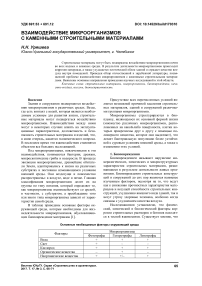Взаимодействие микроорганизмов с каменными строительными материалами
Бесплатный доступ
Строительные материалы могут быть подвержены воздействию микроорганизмов почти во всех водных и влажных средах. В результате деятельности микроорганизмов происходит коррозия материала, а также ухудшается эстетический облик зданий и страдает качество воздуха внутри помещений. Проведен обзор отечественной и зарубежной литературы, посвященной проблеме взаимодействия микроорганизмов с каменными строительными материалами. Выявлены основные направления проведения научных исследований в этой области.
Строительные материалы, микроорганизмы, биоповреждение, качество воздуха, плесень, биовосприимчивость
Короткий адрес: https://sciup.org/147154499
IDR: 147154499 | УДК: 691:53 | DOI: 10.14529/build170310
Список литературы Взаимодействие микроорганизмов с каменными строительными материалами
- Карамова, Н.С. Методы исследования и оценки биоповреждений, вызываемых микроорганизмами: учеб.-метод. пособие/Н.С. Карамова, Г.В. Надеева, Т.В. Багаева. -Казань: Казанский университет, 2014. -36 с.
- Bertron, A. Understanding interactions between cementitios materials and microorganisms: a key to sustainable and safe concrete structures in various contexts/A. Bertron//Mater. And Struct. -2014. -Vol. 47. -P. 1787-1806.
- Alexander, M.G. Performance of sewer pipe concrete mixtures with portland and calcium aluminate cements subject to mineral and biogenic acid attack/M.G. Alexander, C. Fourie//Mater. Struct. -2011. -Vol. 44, no. 1. -P. 313-330.
- A new test method to assess the bacterial deterioration of cementitious materials/C. Magniont, M. Coutand, A. Bertron et al.//Cem. Concr. Res. -2011. -Vol. 41, no. 4. -P. 429-438.
- An innovative approach to reproduce the biodeterioration of industrial cementitious products in a sewer environment. Part I: test design/M. Peyre Lavigne, A. Bertron, L. Auer et al.//Cem. Concr. Res. -2014.
- Chemical, microbiological, and in situ test methods for biogenic sulfuric acid corrosion of concrete/J. Monteny, E. Vincke, A. Beeldens et al.//Cem. Concr. Res. -2000. -Vol. 30, no. 4. -P. 623-634.
- Influence of the intrinsic characteristics of mortars on their biofouling by pigmented organisms: Comparison between laboratory and field-scale experiments/T.H. Tran, A. Govin, R. Guyonnet et al.//Int. Biodeterior. Biodegrad. -2014. -Vol. 86. -P. 334-342.
- Accelerated laboratory test to study fungal biodeterioration of cementitious matrix/V. Wiktor, F. De Leo, C. Urzì et al.//Int. Biodeterior. Biodegrad. -2009. -Vol. 63, no. 8. -P. 1061-1065.
- An innovative approach to reproduce the biodeterioration of industrial cementitious products in a sewer environment. Part II: validation on CAC and BFSC linings/M. Peyre Lavigne, A. Bertron, C. Botanch et al.//Cem. Concr. Res. -2014.
- Васильева, Н.В. Микроорганизмы -контаминанты и патогены -индукторы процессов старения больничных зданий и помещений медицинского назначения, а также возбудители некоторых заболеваний людей: учеб. пособие/Н.В. Васильева, Н.П. Елинов; под ред. Н.П. Елинова. -СПб.: КОСТА, 2009. -224 с.
- Mudarri, D. Public health and economic impact of dampness and mold/D. Mudarri, W.J. Fisk//Indoor Air. -2007. -Vol. 17, no. 3. -P. 226-235.
- A review of indoor microbial growth across building materials andsampling and analysis methods/T. Verdier, M. Coutand, A. Bertron, C. Roques//Building and environment. -2014. -Vol. 80 -P. 136-149.
- Фатыхова, Ю.Н. Роль структуры сообществ хемолитотрофных микроорганизмов в разрушении строительных силикатных материалов: дис. … канд. биол. наук/Ю.Н. Фатыхова. -Томск, 2006. -125 с.
- Indoor fungal contamination of moisture-damaged and allergic patient housing analysed using real-time PCR/A.-P. Bellanger, G. Reboux, S. Roussel et al.//Lett. Appl. Microbiol. -2009. -Vol. 49. -P. 260-266.
- ГОСТ 9.053-75. Единая система защиты от коррозии и старения (ЕСЗКС). Материалы неметаллические и изделия с их применением. Метод испытаний на микробиологическую стойкость в природных условиях в атмосфере (с Изменением 1). -http://www.gostedu.ru/16657.html.
- ГОСТ 9.049-91. Единая система защиты от коррозии и старения (ЕСЗКС). Материалы полимерные и их компоненты. Методы лабораторных испытаний на стойкость к воздействию плесневых грибов. -http://docs.cntd.ru/document/1200015007.
- GGTM. P040. Method for Measuring Microbial Resistance from Various Sources (based on ASTM D6329). -http://greenguard.org/Libraries/GG_Documents/GGTM_P040_Method_for_Measuring_ Microbial_Resistance_from_Various_Sources_071221. sflb.ashx.
- Khan, B.A. Antibacterial properties of hemp and other natural fibre plants: a review/B.A. Khan, P. Warner, H. Wang//Bio Resources. -2014. -Vol. 9, no. 2. -P. 3642-3659.
- Pacheco-Torgal, F. Cementitious building materials reinforced with vegetable fibres: a review/F. Pacheco-Torgal, S. Jalali//Constr. Build. Mater. -2011. -Vol. 25, no. 2. -P. 575-581.
- Titanium dioxide based strategies to prevent algal fouling on cementitious materials/A. Maury-Ramirez, W. De Muynck, R. Stevens et al.//Cem. Concr. Compos. -2013. -Vol. 36. -P. 93-100.
- Сураева, Е.Н. Разработка сухих строительных смесей с биоцидными свойствами: дис.... канд. техн. наук/Е.Н. Сураева. -Саранск, 2015. -170 с.
- Родин, А.И. Разработка биоцидных цементов и композитов на их основе: дис.... канд. техн. наук/А.И. Родин. -Саранск, 2013.-205 с.
- Bioreceptivity evaluation of cementitious materials designed to stimulate biological growth/S. Manso, W. De Muynck, I. Segura et al.//Sci. Total. Environ. -2014. -Vol. 481. -P. 232-241.
- Wiktor, V. Quantification of crack-healing in novel bacteria-based self-healing concrete/V. Wiktor, H.M. Jonkers//Cem. Concr. Compos. -2011. -Vol. 33, no. 7. -P. 763-770.
- Belie, N.D. Microorganisms versus stony materials: a love-hate relationship/N.D. Belie//Mater. Struct. -2010. -Vol. 43, no. 9. -P. 1191-1202.
- Decho, A.W. Overview of biopolymer-induced mineralization: What goes on in biofilms?/A.W. Decho//Ecol. Eng. -2010. -Vol. 36, no. 2. -P. 137-144.
- Soleimani, S. Resistance of biofilm-covered mortars to microbiologically influenced deterioration simulated by sulfuric acid exposure/S. Soleimani, O.B. Isgor, B. Ormeci//Cem. Concr. -2013.


